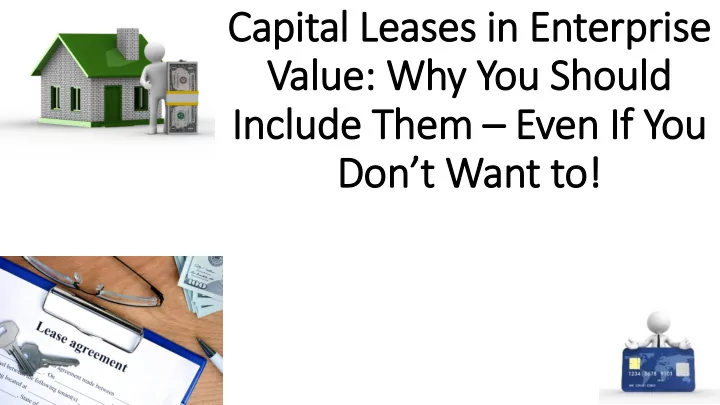

Capital Leases in Enterprise Value: Why You Should Include Them – Even If You Don’t Want to!
Capital l Leases in Enterprise Value “Your treatment of capital leases in Enterprise Value is wrong!” “You should NOT add capital leases, or any leases, when moving from Equity Value to Enterprise Value, because they’re all operational items, not Debt.”
Capital l Leases in Enterprise Value • SHORT ANSWER: You could make that argument, and there is some disagreement over the nature of leases… • But: From a practical perspective , you pretty much have to add capital leases so that you get consistent valuation multiples • Problem: If you do not add capital leases, then you have to adjust the denominators of valuation multiples such as EV / EBITDA • Theoretically: This approach might work, but most companies do not disclose enough information to make the required adjustments
Leases 1 101: Operating vs. Capital • Operating Leases: Company signs an agreement to pay a set amount of rent each year; no ownership of the asset • Income Statement: Expense shows up as “Rent” within the company’s Operating Expenses • Capital Leases: The company records the Leased Asset as PP&E on the Balance Sheet, and the lease is counted as Debt on the L&E side of the Balance Sheet • Income Statement: No rental expense, but the company records Depreciation on the Asset and Interest Expense on the Debt
THE PROBLEM: Valuation Multiples • RULE: If you include a Balance Sheet item in the numerator of a multiple, you exclude the corresponding expense in the denominator (i.e., add it back) • And: Vice versa if you exclude an item in the numerator • Example: Debt is included in Enterprise Value, so in the EV / EBIT and EV / EBITDA multiples, you exclude the corresponding Interest Expense in the denominator • So: Think about the problems this rule creates for the treatment of capital leases…
THE PROBLEM: Valuation Multiples • Add Capital Leases: Then it’s easy to calculate EV / EBITDA – because EBITDA already excludes all Depreciation and Interest! • By definition , then, the Depreciation and Interest from capital leases are also excluded from EBITDA, and this rule is satisfied • BUT: What happens if you do not add capital leases when moving from Equity value to Enterprise Value? • Then: You need to adjust a metric like EBITDA so that it includes the Depreciation and Interest from capital leases (i.e., you have to subtract those items ) – and then it’s no longer EBITDA!
THE PROBLEM: Valuation Multiples • Adjustments: EBITDA – Interest on Capital Leases – Depreciation on Capital-Leased Assets • Problem #1: What do you even call this new metric? “EBITDA Adjusted for Capital Leases?” What does that mean? • Problem #2: Does the company disclose enough information to make this calculation? Probably not! • Many Companies: Won’t break out Interest and Depreciation from different sources separately, or might lump all expenses associated with capital leases together (including principal repayments!)
Our Recommendation: Keep It Simple • So: We recommend keeping it very, very simple, and adding capital leases when moving from Equity Value to Enterprise Value • Why: Not because of the “philosophical arguments,” or because we think all leases are financial in nature, but because of practicality • Ideal: Use standard metrics, such as EBITDA, that everyone is familiar with and that can be easily defined and calculated • Avoid: New, non-standard metrics or numbers that require footnotes or additional explanation
Recommend
More recommend